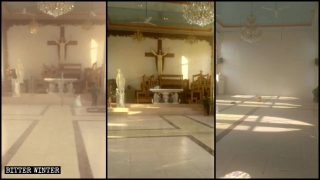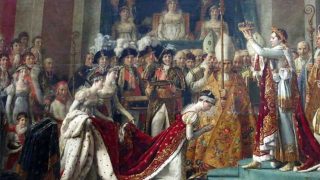A daring AsiaNews analysis of the cost-effectiveness of the 2018 Vatican-China Deal recalls the sad precedent of the Napoleonic attempt to subdue the Church.
Marco Respinti
Famously, Chinese Premier Zhou Enlai (1898-1976) said to American President Richard M. Nixon (1913-1994), during the latter’s historic visit to China in February 1972, that it was “too early” to assess the implications of the Revolution in France. For a long time, it was commonly understood that Zhou was referring to the French Revolution that exploded in 1789 and lasted a decade. American diplomat Charles W. “Chas” Freeman Jr., who was present at the meeting, later said that the Chinese leader was, in fact, referring to turmoil in France in 1968. But Zhou was correct in either case. It is too early, even today, to evaluate the damage produced by the so-called “French May” and its aftermath (which, interestingly enough, was rather full of self-styled fans of Chairman Mao). And it is too early also to tell when the mother of all political revolutions, to which the Communist revolution owes so much, will end. If ever.
Anti-Catholicism in France two centuries ago
Karl Marx (1818-1883), the German father of communism, was a keen student of the French Revolution. He judged it severely as an incomplete, bourgeois revolution. Nonetheless, he thanked the French bourgeoisie for the crucial role they played in wiping out as much as possible of the so-called Ancient Regime, which was an entente (somewhat) cordiale between the Catholic Church and the state that helped to conserve a fundamentally Catholic society. Marx knew that Revolution is a process, advancing, through centuries, step by step, and that the philosophy of “everything now” dooms revolutions irreparably. During the French Revolution, there were even proto-communists like writer François-Noël “Gracchus” Babeuf (1760-1797) and journalist Jacques-René Hébert (1757-1794), but they had appeared too early on the calendar of history. Thus, while envisioning a collectivist society that was to come of age much later in many parts of the world, they were sent to the guillotine by the French terrorists (this was the name chosen by the leading faction of the Revolution at the time of its violent climax) whom on one side they admired but on the other they criticized for not being extremist enough.
The revolution that burst out in France more than two centuries ago has inaugurated the modern State. Its premises are, of course, older, but revolutionary France was the first state to experiment, successfully, with full-scale totalitarianism. Revolutionary France was the first totalitarian state in history – and also the first genocidal state (I will return to this point).
When its bloody and absurd rule came to its apogee, society reacted all across the nation. There was a time, in 1793, when about 60 percent of the whole French territory was revolting in arms against the central revolutionary government in Paris. The most famous rebellion took place on the northeastern coast of France, in a region that historians have named “Military Vendée,” a region much bigger than the original Vendée department where it all began.
The revolt in Vendée was essentially a Catholic revolt against a totalitarian government for the right to believe.
The Parisian revolutionary government had in fact gone through a number of devastating anti-Catholic measures since the first days of its inception: nationalizing monasteries and convents and seizing their properties, attacking priests and nuns, suppressing the religious orders, and killing believers and churchmen, and people with disabilities and the poor (the famous massacres of September 1792, which have been compared to the 1939-1941 German National-Socialist Aktion T4 to impose euthanasia on the handicapped). The peak was reached when the revolutionary government imposed on Catholic priests an oath of loyalty to the state which meant obeying the regime in all matters, including religious questions, and when King Louis XVI (1754-1793) was beheaded theatrically in Paris. The killing of the Bourbon king was, in fact, performed as a dramatized attack on God: since it was not possible to hurt God himself, the revolutionaries wanted to hit God’s subsidiary authorities on Earth, the king and the pope.
Since the high Middle Ages, in fact, the people of France perceived the king as the embodiment of political power exerted in the name of God to defend freedom, justice, charity, and religion. With regard to the Papacy, the French revolutionaries wanted to bring it soon to an end. They deported to France Pope Pius VI (1717-1799), who died in Valence-sur-Rhône on August 29, 1799. Later, Napoleon Bonaparte (1769-1821), the astute and subtle true heir of the French Revolution, deported also Pius VI’s successor, Pope Pius VII (1742-1823), who was liberated only when the French tyrant suffered a few important military losses.
Never dare to contradict the state
The misinterpreted 1972 words of Zhou Enlai are not the sole connection between the French Revolution and Communist China. The Vatican-China Deal of 2018 marks an even stronger connection. This is at least the opinion of Li Ruohan (a pseudonym), a scholar from northern China, who has drawn a startling parallel between that agreement and the one signed by Napoleon and Pius VII. Mr. Li makes his case in an article published in English, Chinese, Spanish and Italian by AsiaNews, the official press agency of the Roman Catholic Pontifical Institute for Foreign Missions (PIME), directed by Father Bernardo Cervellera, widely regarded as the leading Catholic expert on China.
After describing the stubborn and cruel anti-Catholic policy of the French Revolution, Li Ruohan significantly points at the total practical failure of the biggest revolutionary attempt to tame the Church. “On July 12, 1790,” he writes, “the revolutionary party promulgated the civil constitution of the clergy, the nucleus of which was a new subdivision of the French dioceses. Before the revolution, France had 134 dioceses. The revolutionaries’ law aimed to unify the dioceses. First of all, the dioceses would be divided according to the boundaries of the administrative regions of the State, reducing them to 51. Secondly, the bishops would be chosen and ordained autonomously. France would have a primate; all the other bishops of France would receive their faculties from the primate. The bishops would be elected by the priests of the diocese. The choice would be made by the priests and some local representatives; even the laity would participate in the election. Third, the primate bishop of France would be proposed by the government, without pontifical appointment. Fourth and very important, all the clergy of France, including bishops and priests, would have to swear an oath, called the ‘oath of loyalty.’ Only after having sworn this oath, would French clergy be allowed to fulfill their public ministry. Those who refused to swear would be judged illegal, not recognized by the French State, considered enemies of the revolution and punishable under the law.”
At that time, Li Ruohan continues, “[..] France had 131 bishops out of 134 dioceses. The bishop’s seat was vacant in three dioceses”. Well, “only four of the 131 bishops signed. Of these four, two returned to secular life,” including Charles-Maurice de Talleyrand (1754-1838), “who was then placed at the head of the Church by the French revolutionary government and several times proceeded to administer sacraments.” As to the lower clergy, “less than a third of the 100,000 French priests took the oath; two-thirds refused to swear. These became the group of non-sworn priests.” As a result, “French Catholics began not to attend churches and refused to receive the sacraments from the hands of sworn priests. The priests who had refused to swear retreated to the countryside of France, where they secretly celebrated mass and administered the sacraments in the homes of the faithful, constituting the group of the non-sworn priests of France.”
The defense of non-sworn priests heavily persecuted by the revolutionaries was the ultimate reason which ignited the Catholic uprising in Vendée, a fight for religious liberty where noblemen sided willingly with peasants, all proudly wearing the rosary around their neck and an image of the Sacred Heart of Jesus over their breast as their common uniform. What did the revolutionary government do at that point? It ordered the complete massacre of the region, wanting to eradicate even the slightest sign of religion and freedom from that land and thus teaching a lesson to all Frenchmen. Never dare to contradict the state, because the toll to pay is genocide. Using blasphemous “secular rites,” the revolutionaries killed thousands and thousands of people, starting with priests and nuns. Women and children were also killed, judged guilty of (women) giving birth to, or (children) on their way to becoming, the rebels of tomorrow. The genocide was perpetrated from late 1793 to June 1794, well after the Vendéeans had been defeated militarily.
Is it worth it?
France was then divided into two Churches, Li Ruohan remembers. One was the official Church created by the state and very unpopular, in terms of affection as well as numbers; the other was the underground Church, faithful to the Pope, harassed and persecuted, but loved and defended by the people. This confrontation and division harshly continued until 1801, when Napoleon decided that not solving the situation could undermine his dream for total power over the minds and hearts of the Frenchmen.
The tyrant volunteered then to settle the situation, offering the Holy See an agreement that was signed in Paris on July 15, 1801. “In the Concordat,” Li Ruohan explains, “the French government recognizes the Roman Catholic Church as the religion of the majority of the French people. The Catholic Church has an inseparable relationship with the history of the French people. In French history, it has played an irreplaceable role. It is therefore right that there is freedom to practice and believe.”
Now, says the Chinese scholar, “this point is apparently commendable and appears aimed at restoring the freedom of the Church of France. But later the government asked the Holy See to make a new division of the dioceses. At the time of the revolution, the 134 dioceses of France were forcibly divided, but the Holy See never recognized the unilateral actions of the French government. However, in the Concordat signed by Napoleon, the Holy See is forced to make concessions, to again divide the dioceses of France, making them correspond to the administrative regions, and to establish new ones. The 134 original dioceses are reduced to 60, including ten archdioceses. All the bishops of France, both those who in the past swore the oath and those who refused to swear, had to resign. The head of the French state, that is, Napoleon, had the power to propose bishops, but the power to bestow jurisdiction is left to the Pope. Regarding the selection of candidates, the most widespread criterion is that they are politically reliable. All the clergy of France, bishops and priests, must take an oath of loyalty to the state. The Church also must renounce the assets confiscated at the time of the revolution. As compensation for the losses, the French government took the maintenance of the clergy upon itself, giving them a subsidy. Moreover, the bishops would be obliged to collaborate with the local authorities, in order to proceed with the division between dioceses and parishes.”
At the end of the day, then, the Holy See didn’t get what it hoped, and Napoleon triumphed. He continued to triumph after being defeated, after being removed from power, and after he had gone and had been buried. The Napoleonic Concordat was, in fact, the model used to craft all the following concordats between the Vatican and France, a nation where the anti-Catholic revolutionary spirit has been alive and kicking, in different shapes and forms, ever since, always inclining one step more to the left – as old Karl Marx had foreseen. The Napoleonic model has then inspired the numerous attempts to separate national Catholic Churches from the Holy See undertaken by the Communist regimes of many countries, from Czechoslovakia to ‒ here we go ‒ China, with varying degrees, and mixtures, of savoir-faire and violence.
Could the Church act differently two centuries ago? In retrospect, all wrong steps become obvious, but it’s easy to be wise after the event. As to China, the time is, on the contrary, too soon to tell. But a fact and a question remain. The point is that when the Church becomes a minority, and a harassed minority, her responsibility to safeguard believers comes first, even if she has to bite the bullet. Martyrdom can, in fact, be accepted by individuals, but it cannot be prescribed to others. The question is instead that posed by Li Ruohan on today’s deal between Rome and Beijing: “is the Holy See certain that it is not simply repeating past mistakes, indeed tragedies?” The Chinese regime keeps giving its side of the answer every day, cracking down on religions.
Source: Bitter Winter / Marco Respinti



